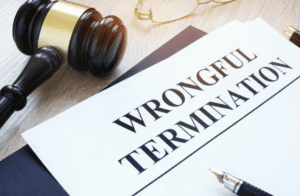 If you’re having trouble at work and you’ve talked to an employment law attorney, he or she might have mentioned sending a “demand letter.” What exactly is a demand letter, though?
If you’re having trouble at work and you’ve talked to an employment law attorney, he or she might have mentioned sending a “demand letter.” What exactly is a demand letter, though?
A demand letter, as the name suggests, is a letter that an employee (often through an attorney) sends to a former employer “demanding” that the employer do something to avoid the filing of a lawsuit. If the employer does whatever the employee demands, the employee will agree not to sue, which lawyers call a “release of claims.” Usually, the demand is to pay the employee an amount of money. A demand could also ask to characterize a firing as a resignation, request a positive reference for future employment, or consist of some other kind of nonmonetary relief.
As you might imagine, the demand letter does not just state the demand. The bulk of the letter usually sets forth an argument as to how and why the employer broke the law. For example, the employer may have terminated someone’s employment illegally, retaliated against an employee, or subjected the employee to a hostile work environment.
Table of Contents
ToggleWhat are the Contents of a Demand Letter?
Contents of a Demand Letter
A demand letter generally includes the following information about your case:
1. Introduction
This section may include basic facts about you and your employment. Bear in mind that the letter will likely be addressed to a high-level executive in human resources or to a company attorney. The recipient probably knows nothing about you. If your attorney sends the demand letter, it may be the first communication from the attorney. In that case, it will have some statement to the effect of, “I am Larry Lawyer. Ms. Smith retained me to represent her in negotiations with the company.”
2. A Description of the Legal Claims Against the Company
Even if what happened to you included only one event, like being fired, you may have several different legal claims from that event. For instance, if you were fired after talking to HR about sexual harassment, you probably have claims for a hostile work environment, sex discrimination, and retaliation. This part of the letter will set out the various claims that you have against the company. Note that when we write a demand letter, we generally assume that the opposing counsel knows the law, so we do not include an extensive legal discussion.
3. Demand
This is the money shot. This is what the company’s lawyer—applying the principle of skip to the end—will look at first. It’s where you (perhaps through your own lawyer) say what you want in exchange for agreeing not to sue. Usually the nonmonetary provisions of your demand are not a concern. These can include a request for a positive reference, for your firing (if you’ve been fired) to be characterized as a resignation, or for the company to not oppose unemployment eligibility.
4. A Drop-Dead Clause
 Some demand letters also include a clause that says, “Reply to us by this date or else.” The “or else” usually threatens that you’ll file a complaint with the EEOC or a lawsuit. Often, the clause will say something like, “If I do not hear from you by this date, I will consider other actions.” What you say here communicates quite a bit. For instance, if you say, “If I do not receive a response by next week, I will file a lawsuit in federal court for violations of Title VII,” that’s a pretty clear line in the sand. In contrast, if you say, “If I do not hear from you by next week, I will consider filing an action in court,” then you’re communicating, “I know a lawsuit is possible. I might file one, but I might not. It depends on what you do.”
Some demand letters also include a clause that says, “Reply to us by this date or else.” The “or else” usually threatens that you’ll file a complaint with the EEOC or a lawsuit. Often, the clause will say something like, “If I do not hear from you by this date, I will consider other actions.” What you say here communicates quite a bit. For instance, if you say, “If I do not receive a response by next week, I will file a lawsuit in federal court for violations of Title VII,” that’s a pretty clear line in the sand. In contrast, if you say, “If I do not hear from you by next week, I will consider filing an action in court,” then you’re communicating, “I know a lawsuit is possible. I might file one, but I might not. It depends on what you do.”
Those are the basics for a traditional demand letter. This kind of traditional demand letter has its pros and cons. The biggest pro factor is that it is an expected and recognized form of communication—at least for an experienced HR professional or attorney. If this letter lands on the desk of the company’s attorney, he or she will know exactly what this is about.
The biggest con is that a traditional stick-’em-up demand letter can have the undesired effect of pushing your employer into a fighting stance. Rather than try to resolve the matter quickly, it will instead want to hit back. Remember, companies are run by people, and it doesn’t often serve the employee’s interest—your interest—to push those people into a corner with a bunch of incendiary threats. For instance: “WE ARE GOING TO FILE A LAWSUIT THAT WILL BANKRUPT YOU AND YOUR FAMILY… but we can make this all go away if you do the following.”
Of course, you want your lawyer to write a really nasty, over-the-top letter. You want to make your former supervisor wet his or her pants.
Go ahead, take a moment to fantasize about that. Done? That was fun, right? Now, put that aside and let the impulse pass.
What Do You Really Want?
 Keep your eyes on the prize. Sending the my-lawyer-is-going-to-bankrupt-your-family letter may not actually get you what you want: a check, a nondisclosure agreement, and a positive reference. In fact, oddly enough, that kind of threatening letter tends to rile up the people who could write a check, making them want to fight rather than encouraging them to cooperate. This is where it is important to harness your emotions and remember your goal.
Keep your eyes on the prize. Sending the my-lawyer-is-going-to-bankrupt-your-family letter may not actually get you what you want: a check, a nondisclosure agreement, and a positive reference. In fact, oddly enough, that kind of threatening letter tends to rile up the people who could write a check, making them want to fight rather than encouraging them to cooperate. This is where it is important to harness your emotions and remember your goal.
What you ideally want is for your employer to look at your letter as an opportunity to resolve a dispute and to make a rational business decision. You want the company to say, “Well, we might win this one, or we might not. Regardless, it’s not worth the time and effort to make a point. And who knows? Maybe she’s got some part of the truth. Let’s settle this thing.” You don’t want your boss to say, “She called me a sexist pig! I might be a sexist, but I am not a pig! Let’s fight this. I don’t care what it costs. I’ll scrap the money for the new advertising budget if I have to. I’d rather pay my lawyer $200K than pay her a dime.”
So, what do you do to avoid triggering that fight? This is where the term “demand letter” is a bit of a misnomer. Not all letters initially sent by your attorney end with “or else.” At our firm, in fact, we sometimes use the initial letter as an attempt to simply start a conversation. We say, essentially, “This is what we know. Why don’t you send us a letter and tell us what you know?”
Why do we it that way? Because it is usually in everyone’s financial interest to settle out of court. And in settlement negotiations, we want the employer to cooperate, usually by writing a check. Of course, there is a bit of coercion involved, even if it’s implicit. Any time a lawyer shows up, there is the threat of a lawsuit, even if that threat is never stated. The employer will usually write the check to avoid a lawsuit.
Another Example of How to Approach a Demand
Let’s walk through this with another example. Suppose you have a tree on the property line between you and your neighbor. It’s mostly on his property, but a lot of the branches hang over onto your property. You don’t particularly like your neighbor. He’s sort of a jerk. Several times, you’ve suggested getting the tree branches trimmed to keep the tree healthy. You’ve offered to split the costs. One year he agreed; one year he didn’t.
 Then one day, the tree fell, oddly, almost exactly on the property line. No one was hurt. But it crushed the fence between your houses and left a big mess with broken branches all over both yards. You need the tree chopped up and removed. But that will be expensive. You want your jerk neighbor to split the cost with you. So, you walk over and offer to make all the arrangements for tree removal and to give him any of the firewood that he wants from the tree. He smiles and says, “Nah. I’m not particularly bothered by it. It can just be our new fence.”
Then one day, the tree fell, oddly, almost exactly on the property line. No one was hurt. But it crushed the fence between your houses and left a big mess with broken branches all over both yards. You need the tree chopped up and removed. But that will be expensive. You want your jerk neighbor to split the cost with you. So, you walk over and offer to make all the arrangements for tree removal and to give him any of the firewood that he wants from the tree. He smiles and says, “Nah. I’m not particularly bothered by it. It can just be our new fence.”
Seething, you walk back to your house and call a lawyer. She tells you that the law in your county is strange. It’s all or nothing in situations like these. The property owner with over 50% of the tree on his property is responsible for the entire cleanup. You schedule a time to go meet with her and show her pictures of the tree. After looking it over, she says this situation is far from clear. It looks like a bit more than half of the trunk was on your neighbor’s property, but courts will also look at the distribution of the tree limbs, and most of those were hanging over your property.
The lawyer says that it looks like you have a good argument that your neighbor should be responsible for all the cleanup. But it is impossible to predict how a court will deal with this. She says it really depends on which judge was assigned to your case, and you can’t know that until you file a lawsuit. She tells you that if your neighbor refused to settle after you filed the lawsuit, you would probably spend more on attorney’s fees than it would cost to just pay for the tree removal. The lawyer suggests you make one more effort to resolve this before hiring an attorney for a lawsuit.
So, you go home to write a demand letter. But now your objective clashes with your desire. Your objective is to get your jerk neighbor to do something that he doesn’t want to do. Your desire is to send him a scathing letter telling him that you’re going to drag his butt into court and beat the stuffing out of him for being a jerk. The problem is that if you send him the letter you want to send him, he’s going to dig in his heels and fight you. And a fight is not going to get that darn tree out of your yard anytime soon.
What to do? This requires a nuanced approach. You know your neighbor: he’s not going to do something if you just ask nicely. He’s also going to fight if you lead off with a bare-knuckles threat. But he might take action if he sees that it is in his best interest to do so. Your objective is to show him that interest, perhaps by saying something like this:
Dear Neighbor,
I wanted to follow up on our recent conversation about that darn tree that is cluttering up our yards.
I appreciate that over the years we have, for the most part, successfully cooperated to deal with this tree. Such a beautiful tree (RIP), but what a mess it’s left!
I appreciate that it is not a priority to move it. You’d rather spend your time and money on the golf course; I’d rather spend mine on my garden. But, ultimately, we’re going to have to deal with it. The county will eventually find both of us in violation of county code. Then we’ll not only have to pay to move the tree debris, but we’ll also have to pay a county fine. Plus, the tree, as I’m sure you’ve noticed, is partially hollow. This makes it an attractive home for raccoons and other animals that could be a nuisance to us both and a danger to your cats.
[Now you will politely telegraph that legal proceedings could follow if you can’t reach an agreement.]Though I sure don’t want to spend a lot of money on a lawsuit, I did consult with an attorney to find out which of us has the legal obligation to remove the tree. The short answer is that it’s unclear because the tree straddled both of our properties. Only a judge could decide which of us had to pay for it, and that would only be after a full, and expensive, trial.
Given that uncertainty, I think the best option for both of us is to split the cost of having the tree removed. I am happy to contact some tree-removal companies and get a few estimates.
[And here’s a version of a drop-dead clause.]Please let me know how you want to proceed by one week from today. The longer that tree sits there, the bigger the mess it’ll make, and the more it will cost to get it cleaned up. You can let me know by letter or feel free to just drop by to talk.
I hope that things are otherwise well with you.
You send the letter. Now what happens? Who knows? In any situation—even for experienced attorneys—you have no idea what is going to happen inside your neighbor’s head. What you hope is that your neighbor makes an effort to settle this with you, either because he wants to be a good neighbor or simply because of his own naked self-interest. (“Dang. Lawyers? Not worth the hassle. Got to settle this.”)
Of course, that may not happen. He might send back his own scorched-earth letter or ignore your letter completely. Of course, these outcomes suggest that your attempt didn’t work. But that’s okay. You can always choose to escalate if a soft approach fails. In contrast, if your first letter is the escalation, it can be difficult to unring that bell.
Summing It Up
- Think about the objective of your demand letter. If you truly want to achieve a settlement, understand that you are trying to get the other side to cooperate with you.
- If you are writing a demand letter to someone who knows about the law, don’t spend a lot of time trying to talk in legalese. Instead, include a short section explaining what laws you think apply to your situation.
- Remember, you can always choose to turn up the heat if your initial kind and gentle approach does not produce results. It is much more difficult, however, to start out throwing punches and then try to make peace.
Do you need help with an employment case or another type of demand letter? Please contact our office so we can help you understand the law that may apply to your case and figure out your next steps.





